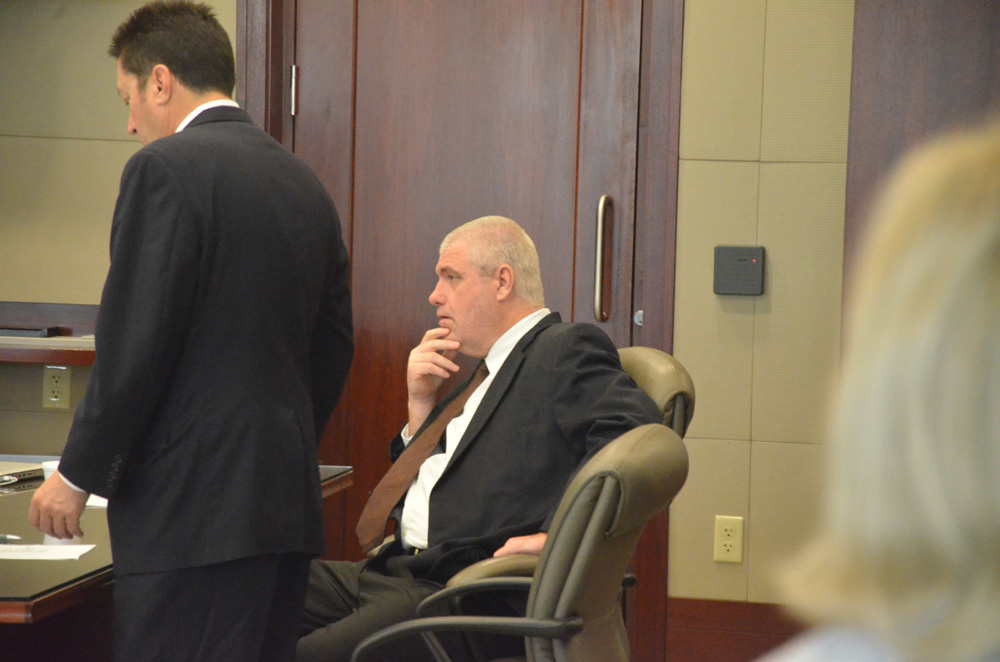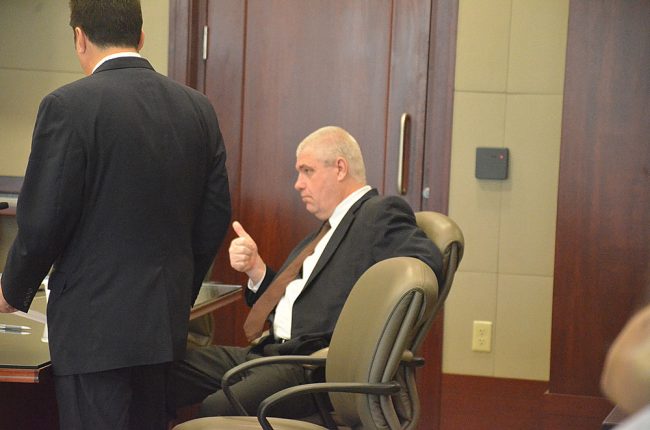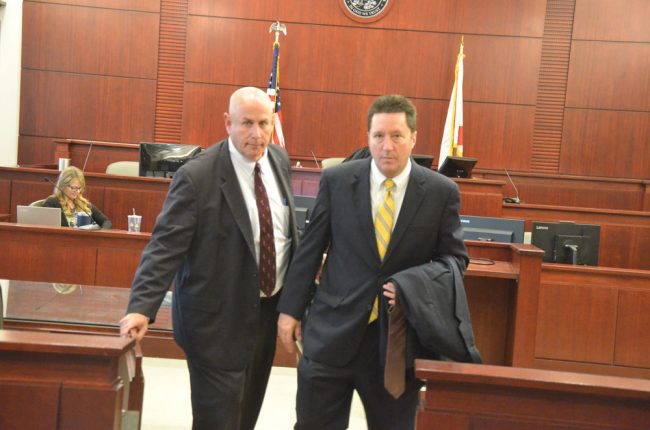
A jury of six men and six women today recommended against death for David Snelgrove in the murders of his neighbors, Glyn and Vivian Fowler, in Palm Coast’s B-Section 20 years ago, instead agreeing with Snelgrove’s defense attorney to “send him back to that place where he can live out the rest of his life in that miserable, God-forsaken environment.” That is, life in prison without parole.
The recommendation, resulting from five minutes short of five hours of deliberations, ends a seven-day penalty-phase trial that again brought out evidence, images, video, testimony and emotions about the murders–with the victims’ daughter in the gallery’s front row throughout–as if Glyn, 84, and Vivian, 79, had been killed months rather than years ago.
The Fowlers’ daughter, who’d brought a ream of faint-yellow tissue paper she’d scrunched in her hands before the verdict, cried in the arms of a victim’s advocate. Snelgrove stared ahead. As during trial, barely a few words had been exchanged with his attorneys until one of his attorneys had to explain to him that he had survived: the recommendations had been confusing, as the jury had found unanimously that the state had proven its case beyond a reasonable doubt–but not enough to outweigh mitigators. Yet for several minutes, the clerk’s reading of the verdict had seemed to be leaning toward a recommendation of death. Even the Fowlers’ daughter had for several minutes thought that the verdict was for death, nodding her head “yes, yes, yes” every time the clerk read that the prosecution had proven beyond a reasonable doubt each of its six elements for a death verdict.
Even Snelgrove was confused, though once the verdict was completed and he understood, he cried. He was sentenced immediately to life in prison–two consecutive life terms without possibility of parole. He later shook hands with bailiffs and with his attorneys.
It was the third time since 2002 that a jury has contended with the question of Snelgrove’s fate in the longest protracted capital case in Flagler County’s history. The first sentence was overturned because the jury’s verdict form did not split the two murder findings, combining them as one instead. The second time, in 2008, the verdict was overturned because the U.S. Supreme Court ruled that lack of unanimity in Florida’s death-recommendation scheme was unconstitutional. The two previous juries had split 7-5 and 8-4 on the death recommendation, which in any other state would have meant that Snelgrove was to get life in prison without parole, ending any further proceedings.

So the prosecution got to have one more go at getting a constitutionally defensible death verdict and almost got it: a juror told FlaglerLive after the verdict that the split had been 10-2 in favor of death, with two younger jurors favoring the mitigators over the aggravators, and a third juror siding with the two, but willing to go with death if the dissenters could be convinced to join the majority: he did not want to be the hold-out, but he could agree with the two as well. They could not be budged. And when the jurors realized that the numbers wouldn’t change, they agreed to concede and announce for life in prison. But that’s what both prosecutors and defense lawyers had told the jurors: it takes just one to disagree with a death recommendation to result in the other outcome.
The verdict now ends the Snelgrove case’s odyssey through the courts. Circuit Judge Kathryn Weston presided over the penalty phase. Had the jury recommended death, then it would have been up to Weston to impose the sentence or opt for life in prison: it would have been at her discretion. Judges seldom overturn a jury’s recommendation, though this case has been particularly fraught with unexpected reversals, a catastrophic error, and the law’s changing goal posts.
Had the case ended in a death sentence, many more years, if not decades, of procedural steps and appeals through state and federal courts would have still been ahead, essentially restarting the appeals clock from near zero.
In essence, that’s where the clock had started when this trial began last week. Even though Snelgrove’s guilt was never in question, the past seven days had been little different from his first trial. The prosecution–Assistant State Attorneys Mark Johnson and Jennifer Dunton–argued that Snelgrove had killed the Fowlers, whom he knew and from whom he’d twice borrowed money that very day, while burglarizing their home in search for more money to satisfy his crack cocaine habit, and that he’d planned to do so knowingly.
The defense–Michael Nielsen and Jeff Stone–argued that Snelgrove is borderline mentally disabled (the law forbids the execution of mentally disabled individuals), that he was high on crack that night, had only planned to burglarize the house, got startled by Gwyn Fowler and lost it.
“They helped him on a day that he took advantage of them and brutally murdered them in their home,” Dunton told the jury. “They were at home, asleep in their beds, the one place on earth that is supposed to be safe to us, our home and our castle, when they were awakened by an intruder we now know is the defendant, and they were beat, stabbed, and choked to death. A peaceful night’s rest ruined and interrupted by fear and violence and pain. That is what this case is about.”
Glyn was struck at least 10 times, stabbed at least three times, and was strangled. He was conscious for at least part of the assault, and attempted to defend himself. Vivian was struck at least 14 times, stabbed in the heart and strangled. She, too, had defensive wounds. Three times over seven days, including during closing arguments, the prosecution showed photographs and a video of the crime scene, letting the images linger in front of the jury, describing them in details with the help of a medical examiner on one occasion, as both Snelgrove and the Fowlers’ daughter wept.
“This is a robbery slash burglary gone bad. That’s what it is,” Nielsen told the jury in his closing arguments. “This is a case where he thinks he’s going in there, he’s going to tiptoe around, and steal some of their property. That’s what’s going on here. He gets startled by Mr. Fowler, and he snaps. He wigs out. And he loses it. There’s no evidence of any premeditation, and it appears that the whole thing is–I’m not going to use the word, a giant cluster–you know the word. No plan, or little, extremely little plan, climbing in the window to try to find some money, hopefully get it and sneak back out. That’s what was going on, plain and simple. What you have here was a strung-out drug addict in the middle of a binge trying to find money to satisfy the next craving. He’s high, his heart was pounding, he’s walking back and forth, pacing outside. Chest beating like a drum. And he makes the god-awful stupid decision to go in that house, he’s confronted by Mr. Fowler, and he loses it. That’s what happened. That’s felony murder.”
In his very last plea to the jury at the end of his 70 minutes’ closing Nielsen sounded almost like a prosecutor but for the nuance in the punishment he was asking for his client–life in prison rather than death: “Please, please, go that way. Life with no parole is a horrible punishment that quite frankly he deserves, and he’s right where he needs to be, see you later, goodbye. Serve out your miserable existence in that God-forsaken place.”
It was an echo of his opening lines, when he described the state’s wish for Snelgrove as a “vote to euthanize him.”
When he walked back to the defense table Nielsen didn’t look at Snelgrove, and Snelgrove didn’t look at Nielsen. There was no other contact.
To make its case, the prosecution had to get a unanimous verdict on at least one “aggravator” in the killings, found to have been proven beyond a reasonable doubt, as long as a single member of the jury didn’t find that the particular aggravator was outweighed by a mitigator put forth by the defense.
The prosecution submitted six aggravators. He was previously convicted of a felony and he was on house arrest, or community control, for a year. (He’d been convicted of tampering with evidence in an Orlando case). He was previously convicted of a violent felony: burglary, robbery and each of the two murders can count as an aggravator when weighed against the other murder. He committed the murders during a robbery, making it a felony murder. He committed it for financial gain. The murder was “especially heinous, atrocious or cruel.” And the victims of the murder were particularly vulnerable because of age.
The defense put up more than four dozen “mitigators,” none of which had to be proven beyond a reasonable doubt. A single juror could find a mitigator to be true based on “the preponderance of the evidence,” and could use that mitigator to outweigh any of the six aggravators. The defense had argued that Snelgrove’s mother had been a drunk while pregnant with him, that he suffered from fetal alcohol syndrome, that he had a smaller head than more than 90 percent of the population, that he’d fallen on his head when he was a toddler, that his father beat him, that he was in special education classes for emotionally disabled students, that he failed most of his classes and dropped out, that he was an addict. It made its case through the testimonies of doctors and family members and scans of Snelgrove’s brain, each of which the prosecution attempted to discredit or ridicule.
“What do we know about Dr. Wu?” Dunton asked of Joseph Wu, formerly of the University of California at Irvine, beginning her inquisition of the expert who’s made a specialty of testifying in such death penalty cases, almost always finding brain abnormalities in the defendants about whom he testifies. The prosecution’s own expert, she said–who has not made a profession of his testimonies, she also said in a slight against Wu–refuted Wu’s claims and methodology. “We do not use these for predictions of any behavior or psychology,” she said of the PET and MRI scans Wu and the defense used. “It’s not accepted practice.”

Nielsen continued: “If this particular case, with all these records, scans, test scores, failings, Ds, Fs, special ed classes, low IQ, if this, ladies and gentlemen, does not satisfy proof for that type of mitigation, what in the world would satisfy the state? Is there no case at all where this mitigation applies? It appears that that’s the way they believe.”
He then provided a list of mitigating circumstances in the form of a litany, each item ascribed to a source–a doctor, a psychologist, a family member, a documented record. He accused the prosecution of making the defense out to be a “conspiracy” to lie–an accusation that drew a sharp objection from the prosecution, which the judge sustained.
The jury had left the courtroom to begin deliberations at 9:38 a.m. Weston had recommended to the jurors to bring an overnight bag, in case they could not reach a decision by nightfall and they’d have to be sequestered in a hotel. It proved unnecessary.
Next month, the very same sort of penalty-phase trial begins for yet another Flagler County death row convict whose sentence was overturned for the same reason that Snelgrove’s was: Cornelius Baker, now 33, convicted in the 2007 kidnaping and murder of 58-year-old Elizabeth Uptagrafft, whose car Baker and his girlfriend Patricia Rosa wanted to steal. That trial will be handled by Circuit Judge Margaret Hudson. A hearing on the case is scheduled for Wednesday at 2 p.m.




























Steve Ward says
So a Convicted murderer get 2X life and we pay, pay, pay while the victims Family pays, pays pays ….smh
amazed says
We always pay. And he is probably still getting high in prison. not suffering. After wiping out 2 innocent old kind neighbors. Poor battered, beaten and deprived of a good life Snelgrove with the tiny head. I know a good 50 people in his similar situation that haven’t committed a single crime. Sorry, Snelgrove is NOT the victim here.
As for the Family of the real victims, this may not be over. 10 years from now some wacky lawyer will get another appeal from a super liberal judge and he may walk free. Which is why DEath would have been better.